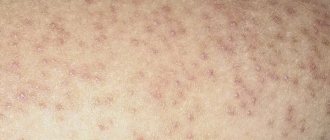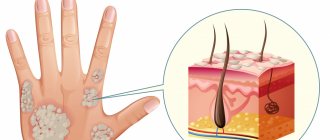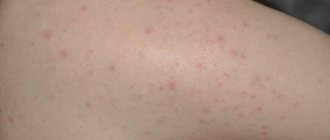What is this?
In fact, there is no such diagnosis of acne . Doctors call painful point inflammations on the skin, often with purulent or serous contents, acne, and the bumps and scars that remain behind them are post-acne. The word "acne" is Greek, translated as "blossoming". The essence of the disease is a malfunction of the sebaceous glands, subcutaneous fat forms a plug, an infection sets in and that’s it – the face, décolleté, back, even the buttocks are “decorated” with unpleasant rashes. Acne affects areas that have a lot of sebaceous glands.
Azelik® is a drug for acne
Only a specialist can understand whether red pimples on the hands are a manifestation of acne or another disease. Therefore, in case of rashes, you should consult a dermatologist. One of the drugs that can be prescribed for mild to moderate acne is Azelik®.
The main component of Azelik® gel is azelaic acid. The foundation also includes an additional component - the emollient squalane, which helps moisturize and soften the skin. The drug has the following properties5:
- normalizes keratinization in follicles;
- has an antimicrobial effect, reducing the colonization of propionibacteria and Staphylococcus epidermidis;
- reduces the concentration of free fatty acids;
- has an anti-inflammatory effect by reducing the metabolism of neutrophils and the free forms of oxygen they produce.
Azelik® must be used twice a day5. Visible effect is usually observed after 4 weeks of use5.
In teenagers
Most often, acne can be seen on a young face. During puberty, when a “hormonal storm” rages, the skin often cannot cope with it. This is very frustrating! Moreover, acne, as luck would have it, always appears before a date or party. By the way, this is no coincidence: stress and anxiety can contribute to the deterioration of skin condition. But the main cause of teenage acne is age itself. They usually appear at 12-13 years of age and are finally completed by 20-24 years of age.
Among women
Ladies often suffer from acne. And there is a reason for this too:
- poor skin care,
- insufficient cleansing
- illiterate selection of cosmetics
Those who use theatrical makeup at work also encounter acne: stage cosmetics create the effect of a mask, the skin under it does not breathe, and fat is not removed.
Acne is also loved by those who strive for super hygiene. Too thorough degreasing of the skin violates its protective layer, making it vulnerable. Thus, to ensure that pimples appear as rarely as possible, individually tailored skin care is necessary. It is best for the diagnosis and selection of products to be performed by a professional - a cosmetologist.
Acne on the body can appear due to wearing clothes that are too tight, non-absorbent and non-breathable.
In men
Acne in the stronger sex has its own characteristics. Most often this is a signal of internal problems, for example with digestion:
- Alcohol abuse
- fatty spicy food
- diseases of internal organs may manifest themselves initially as acne on the face
- Shaving can also cause acne as it regularly damages the hair follicles.
And, of course, there is genetics: if your loved ones have had acne, unfortunately, your risk of acne is very high.
Eczema51
Eczema is a chronic allergic skin disease, which is characterized by the appearance of a polymorphic rash, acute inflammation, and itching.
The acute stage of the disease is characterized by the appearance of edema, erythema, against which vesicles, serous crusts, and punctate erosions with weeping are formed; papules and pustules with sterile contents are less often formed. If the pimples on the hands itch, this may indicate dyshidrotic and pruriginous eczema. So, with dyshidrotic eczema, the skin of the palms may become covered with itchy blisters and velculi. Pruriginous eczema is characterized by the appearance of small papulovesicles, mainly formed on the face and elbows, which can also cause itching.
Eczema develops due to neuroendocrine disorders, genetic predisposition, vegetative-vascular, metabolic, infectious and allergic factors.
What not to do when acne appears
There is a strict prohibition on certain actions with acne. First of all, you cannot squeeze them out yourself, at home. You can get an additional infection, the number of acne will only increase, and the risk of sepsis is high.
It is extremely undesirable to self-medicate, especially if the inflammatory process is severe and its cause is unclear. Non-professional home care can further injure the skin and disrupt the natural process of sebum production.
Pharmaceutical products for acne and acne can only be used as prescribed by a doctor. They often contain antibiotics, which will reduce the local immunity of the skin. The same applies to the uncontrolled use of vitamin A preparations: they can lead to retinoic dermatitis. It is strictly forbidden to use ointments and creams with hormones for acne.
Rash on a child's legs and arms
RASHE IN A CHILD ON THE LEGS AND HANDS WITHOUT FEMPERATURE, WITH FEMERATURE, ITCHES, DOES NOT ITCH
Children are the most beloved, defenseless people. The health of the baby sometimes depends on adults. They need our attention first. Children's skin is still imperfect and very susceptible to various infections. Thus, the appearance of a rash on the arms and legs may be an innocent manifestation, or it may be a signal of a dangerous disease. Below we will consider why a rash may appear in a child and how to act in this situation.
Rash - what is it?
What is this phenomenon? A rash is a pathological change in the skin and mucous membranes that differs from normal skin in appearance, structure, and color. It can be primary or secondary, that is, appear at the site of previous rashes. The combination of primary and secondary elements determines the picture of the rash in the disease. This may be a reaction to some allergen, or it may turn out that the rash is a sign of some disease.
Kinds
It turns out that rashes come in different natures and types. Primary and secondary rashes are distinguished. This is what a rash happens on a child’s legs and arms:
- The tubercles do not have a cavity, are located deep in the dermis, up to 1 cm in diameter. At the same time, the color and texture of the skin is different. They can leave scars and develop into ulcers.
- Blisters are without a cavity, have blurry outlines and are pink in color. Appear due to swelling of the papillary dermis. They pass without a trace, they itch.
- Papules or nodules - do not have a cavity. They may or may not be inflamed and their color has changed. They pass without leaving a trace
- Bubbles - have a bottom, a tire, a cavity. Once they are opened, erosion can occur.
- Pustules or pustules have pus inside. May be superficial or deep.
- Roseola appears as irregularly shaped pink spots. When the skin is stretched, the stain disappears.
If the rash appears again, then the following may form:
- Scarring.
- Abrasions.
- Cracks.
- Scales.
- Erosion.
- Ulcers.
Diagnostics
If a rash appears on your child’s legs and arms, you should urgently seek help from a pediatrician and dermatologist. First, the doctor should carefully examine:
- View.
- Form.
- Color.
- Quantity.
- The nature of the rash.
- The location of the rash is also important.
Next it turns out:
- Presence or absence of fever.
- What infectious diseases have you suffered?
- What hereditary diseases are there?
- Tendency to allergies.
- Photosensitivity.
As a rule, a rash is not the underlying disease, but is a symptom of some disease. It is a sign that a malfunction has occurred in the body. To determine the cause of this manifestation, the doctor prescribes tests. First of all, a blood and urine test. It is also possible to analyze the secretion of ulcers. After examination and analysis, the doctor prescribes treatment. What could be the reasons why a child has a rash on his legs and arms?
Sources of the problem
For a child’s body, a rash is a very important symptom of certain diseases, so consulting a doctor is important. The reasons for this may be the following:
- Allergic diseases.
- Infectious.
- Parasitic infections.
- Vascular and blood diseases.
- Violations of hygiene rules.
If the rash accompanies an infectious disease, the body temperature will certainly increase. There are other signs, these could be:
- Cough.
- Rhinitis.
- A sore throat.
Let's look at some diseases that are accompanied, in addition to a rash, also by fever.
Rash with fever
When an infection enters the body, its first reaction is fever. Skin rashes can appear with or without fever. There are several infectious diseases, the symptom of which is a rash.
This group includes:
- Chicken pox.
- Rubella.
- Scarlet fever.
- Measles.
- Enterovirus infection.
- Meningococcemia.
Each disease has its own characteristics of the spread of rashes. This is especially true for childhood diseases. Let's look at which of them cause a rash on the child's legs and arms, as well as on the body and face.
Chickenpox
This disease occurs most often in children. There are no vaccinations for it. The first sign of this disease is the appearance of red spots, which very quickly turn into blisters. In addition to blisters on the face, head, and body, the child also has a rash on the legs and arms. The temperature is elevated, and the baby may experience weakness and headache for some time.
If the blister is torn off, scars remain. The main problem of this disease is that the rash on the child’s arms and legs itches, and there is a risk of infection. The doctor may prescribe medications to relieve itching.
Rubella
This disease occurs with elevated temperature. In older children, joint pain and general intoxication are possible. Rashes appear on the 1st day or on the second day. First - on the face, neck, torso, then a small rash spreads on the child’s arms and legs, mainly on the folds. The younger the child, the milder this disease occurs. However, in adolescents, complications such as encephalitis and meningoencephalitis are possible. This disease is especially dangerous for pregnant women; fetal developmental defects are possible. Vaccination is also prohibited for immunocompromised patients. However, rubella is milder than scarlet fever.
Measles
A dangerous infectious disease, easily transmitted through the air with minor contact with a carrier of the infection.
There is a vaccine against measles. This disease is accompanied by intoxication of the body. Symptoms characteristic of a cold are present - coughing, watery eyes, sneezing. The temperature rises to high values. The rash begins from the mucous membrane of the cheeks, then moves to the face, the entire torso, and limbs (in the form of papules rising above the skin). Dangerous complications on the bronchi, can cause pneumonia.
Scarlet fever
This is an infectious disease transmitted by airborne droplets, through dirty hands and objects. It starts with a sore throat and chills. Then a small rash appears on the child’s arms and legs with fever. Most often in the bends of the arms and legs. The rash then spreads to the face, neck, and torso. The source of the rash is streptococcus. The throat begins to hurt, which is very similar to a viral infection. The main thing for definition is language. It will be raspberry in color. As soon as the temperature begins to decrease, lamellar peeling of the skin of the hands and feet begins. With this disease, it is very important to maintain bed rest and drink fluids. Antibiotics are required for treatment. Complications to the heart and kidneys are possible.
Enterovirus infection
Preschool children are susceptible to these diseases. A rash appears on the child’s legs and arms without fever. It usually doesn't itch
The child may be healthy or there may be a slight increase in temperature within one or two days. This occurs due to imperfections and sensitivity of children's skin.
Meningococcemia
This is a very dangerous disease. The temperature rises to high levels in a short period of time. A rash appears on the child’s legs and arms (it does not itch) in the form of irregularly shaped hemorrhage, and is also present on the buttocks. If such rashes are detected, you should urgently call a doctor and admit the child to intensive care.
Hemorrhagic vasculitis
This disease is characterized by a rash on the child’s arms and legs with fever, mainly in the area of the folds. At first, small blisters or lumps appear, then the rash turns red, acquires the color of rust, and disappears completely. It is believed that the disease can be caused by allergies, trauma, or be a consequence of acute infectious diseases such as tonsillitis, pharyngitis. Accompanied by fever and joint pain. With the lightning-fast course of this disease, death is possible. It is necessary to pay careful attention to treatment.
Non-infectious rash with itching
There are a number of diseases in which the rashes are very itchy. For example, with scabies, a rash appears on a child’s legs and arms without fever, most often on the folds between the fingers. As a rule, it itches a lot, especially at night. Also, with helminthiasis, the rashes itch
The presence of fungus on the skin of children is one of the causes of rashes in the form of blisters, erosions, and red spots. The localization of the fungus is usually on the legs, palms, feet, and wrists. The rash spreads especially quickly on moist areas of the skin. Can be easily transmitted through contact with a contaminated object. Infections occur especially often in places where there is a damp environment (shower, bathroom). The disease is accompanied by severe itching without fever.
Small rash without itching
If a small rash appears on the child’s arms and legs and does not itch, pseudotuberculosis may be at the initial stage of development. This disease is transmitted by rodents - after contact with things to which they had access. This disease appears very rarely in children, but it still exists.
If a child was born with congenital syphilis or was infected in utero, the rash may appear from time to time without bothering him. These are papules with a pustular core. Such rashes are not accompanied by itching and fever. Also, a small rash can be the result of a hereditary infectious disease such as psoriasis. In children under 2 years of age it is rare, but at an older age the risk of development, due to heredity, is quite possible. It begins with a small rash in the form of dry plaques of round and oval shape, red-pink in color, with noticeable peeling on top. It spreads over large areas of the skin, in the area of the knees, elbows, and head - this is a characteristic sign of psoriasis. This rash does not itch. In infants it can appear and go away, and in adulthood it can return again.
Allergic reaction
With allergic dermatitis, in addition to rashes on the face and torso, the child may have a rash on the legs and arms. The photos clearly demonstrate the manifestation of an allergic reaction. Rashes can be present either on a small area of skin or on a large one. As a rule, accompanying symptoms are peeling and severe itching. The body temperature remains within normal limits, and no intoxication of the body occurs. This reaction is possible to food, household chemicals, and medications. If a child has allergies, you need to be extremely careful with allergens and exclude them from the diet if possible, as there is a risk of angioedema. Possible respiratory arrest and laryngeal swelling.
Hives - a small rash - can be a reaction to temperature factors, cold, or sun.
What not to do if a rash is detected in a child
First of all, it is strictly prohibited in situations where you see rashes on your baby’s body:
- Squeeze out pustules.
- Pop bubbles.
- Treat with brilliant green or other means until examined by a doctor.
- Self-medicate.
If the rash on your child's arms and legs itches, do not let him scratch it. If a rash is detected, you should limit contact with others, as the disease may be contagious. As we saw earlier, a rash can be an important symptom or result of a disease. An examination by a doctor is required to make a correct diagnosis and prescribe appropriate treatment to eliminate possible complications.
Therapy
Treatment of rashes is, first of all, elimination of the disease that caused them. For infectious diseases, it is recommended to adhere to bed rest, take antipyretics, antihistamines, and treat rashes. If necessary, antibiotics are prescribed (to avoid the development of side effects). Allergy sufferers should definitely see an allergist. It is necessary to exclude allergens from your diet. You should also follow your doctor’s instructions and take antihistamines or glucocorticosteroids. In case of fungal diseases or scabies, observation by a dermatologist is necessary.
Rash prevention
The skin in childhood is not yet adapted to the manifestations of the external environment, so it requires special attention and care. First of all, it is necessary to observe the rules of hygiene. Parents should ensure that all necessary vaccinations against dangerous diseases are received. If your baby suffers from allergies, be sure to see an allergist. Proper treatment and observation will help the child outgrow this difficult period. Eliminate allergens from your baby's diet. Strengthen your child’s immunity so that he can fight diseases easily and without consequences.
Do not leave any rash, even a minor one, unattended!
How to get rid of acne?
Maintaining a healthy lifestyle significantly reduces the risk of acne. Let us remind you that this
- adequate drinking regime
- reducing fast carbohydrates in the diet
- outdoor walks and sports
- exclusion of tobacco and alcohol
Modern aesthetic cosmetology helps you forget about acne. Depending on the causes of acne, stage and associated skin problems, the doctor will select the appropriate method. This can be laser therapy, injection techniques - mesotherapy, biorevitalization, plasma therapy, treatment with the HydraFacial device, peelings, etc. But it is important not to delay contacting a specialist: the sooner you start the procedures, the easier and faster it is to get rid of unsightly painful rashes.
Allergic contact dermatitis51
One of the most common causes of pimples on the hands is allergic contact dermatitis (ACD). It is an inflammatory reaction of the skin that occurs in response to external irritants. Occurs in a sensitized organism. Inflammation in ACD is a manifestation of delayed-acting hypersensitivity, which manifests itself 10-15 days after contact with the allergen.
ACD can be caused by contact with the following substances:
- metals;
- adhesives;
- cosmetics;
- external medications;
- dyes;
- chemicals, for example, rubber, cement, etc.;
- food products (in case of contact with skin);
- plants.
The rashes are located not only in the place that was exposed to the irritant, but also in other areas. In addition to the rash, patients may notice other subjective manifestations: itching, burning, pain. It is imperative to visit a dermatologist.











